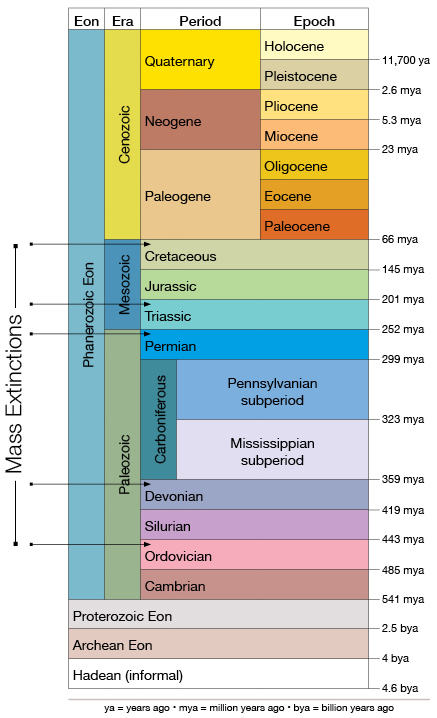When Did the Last Mass Extinction Occur Apex
The Cenozoic era began about _____ years ago. The end of the Ice Age.

Pin On Best Of Science That Stuff
Birds were given a lucky break by evolution which set in motion the events that led up to the asteroid striking.

. Many evolutionary family trees got the ax so to speak during a mass extinction. Cretaceous-Paleogene extinction 66 million years ago The Cretaceous-Paleogene extinction event is the most recent mass extinction and the only one definitively connected to a major asteroid impact. 26 What happened after the dinosaurs died.
These five mass extinctions include the Ordovician Mass Extinction Devonian Mass Extinction Permian Mass Extinction Triassic-Jurassic Mass Extinction and. The Great Dying was caused by an enormous volcanic eruption that filled the air with carbon dioxide which fed different kinds of bacteria that began emitting large amounts of. More than 2 billion years ago Earths early organisms released oxygen into the atmosphere.
Due to very scientific reasons mass extinctions occur after a certain period of time. These thresholds are linked to carbon cycles and timescales. The biggest extinction event was the devastating End-Permian extinction event 251 million years ago where 96 of all species disappeared.
According to Rothmans hypothesis mass extinction in the past has occurred when one of two thresholds was crossed. The end-Permian extinction occurred 2522 million years ago decimating 90 percent of marine and terrestrial species from snails and small crustaceans to early forms of lizards and amphibians. At the beginning of this era.
21 What happened at the end of the Mesozoic Era but did not happen. The most famous mass extinction event occurred 65 million years ago and resulted in the extinction of nearly all dinosaur species. 22 Which eras ended with a mass extinction apex.
Throughout the 46 billion years of Earths history there have been five major mass extinction events that each wiped out an overwhelming majority of species living at the time. The period of the extinction was around 383-359 million years ago. Since the beginning of the Cenozoic era the climate has _____.
During this period mostly marine species were present. At the beginning of this period. This mass extinction which occurred 251 million years ago is considered the worst in all history because around 96 of species were lost.
How did oxygen come to make up 21 percent of earths atmosphere. The Holocene extinction otherwise referred to as the sixth mass extinction or Anthropocene extinction is an ongoing extinction event of species during the present Holocene epoch with the more recent time sometimes called Anthropocene as a result of human activity. 27 What happened to the meteor that hit Arizona.
25 When did the last meteor hit Earth. In the 540 million-year history of life on the planet Earth has been witness to five mass extinction events. When did the last mass extinction occur.
The extinction occurred around 444 million years ago eliminated around 85 percent of all Ordovician species. About 66 million years ago a terrible extinction event wiped out the dinosaurs. 65 million years ago.
The Great Dying as its now known was the most severe mass extinction in Earths history and is probably the closest life has come to being completely. Ancient coral species were completely lost. 23 How did all the dinosaurs get extinct.
Is the Earths atmosphere an element. But it wasnt the only event of this kind -- extinctions of various severity have occurred throughout the Earths history -- and are still happening all around us today. The fifth and most famous extinction event is the catastrophe that wiped out the dinosaurs called the End-Cretaceous event.
Borths DEmic and Pritchard give a quick history of mass extinctions. That is the 1 percent of species on Earth not yet extinct. A geologic break between the two occurred about 65 million years ago and beaked birds were the only dinosaurs to survive.
By figuring out the timing and rate of the worlds most massive extinction 252 million years ago scientists hope to figure out how such lethal events work. Updated on January 08 2020. 24 What happened to bring an end to the Permian period.
At the beginning of this epoch. A mass extinction of 95 of marine species and 70 of land vertebrate species What is the Cretaceous-Paleogene often referred to as the K-T event. For the last 35 billion or so years about 99 percent of the estimated 4 billion species that ever evolved are no longer around.
Congratulations youre part of the 1 percent. What caused the disappearance of land bridges. The included extinctions span numerous families of bacteria fungi plants and animals including mammals.
The CretaceousTertiary extinction event 65 million years ago was the last mass-extinction and many believe that humans are causing a mass-extinction right now. When did the last mass extinction occur apex. When did the last mass extinction occur.

Joschua Knuppe On Twitter Animals Paleo Art Zoology

Prognathodon Saturator Late Cretaceous Discovered In 1998 Fossil Teeth Dinosaur Era Fossil

Wolves As A Keystone Species Change Rivers In Yellowstone Keystone Species Yellowstone Species

Mass Extinction Facts And Information From National Geographic

View Image Prehistorics Illustrated Dinosaurs Prehistoric Animals Extinct Animals Prehistoric Creatures

Lurdusaurus Prehistoric Wildlife Dinosaur Simulator Prehistoric Creatures

Pin On Your Cat As A Helicopter 图 牠

Ice Concept Three Extinction Jurassic Climate Change

Insights Into Climate Change During Origin Of Dinosaurs Climate Change Climates Geology

Earth Is Not In The Midst Of A Sixth Mass Extinction The Atlantic

Island Hateg By Atrox1 On Deviantart Prehistoric Creatures Prehistoric Animals Prehistoric

Extinction Events Six Times The World Ended Lethbridge News Now

Jurassic Sub Boreal Seaway Feeding Guilds New Study Of Fossil Teeth Hints At Jurassic Marine Faunal Turnover Fossil Teeth Marine Palaeontology

Pin By Ricardo Melo On Science Historical Geology Explosion Prehistoric World




